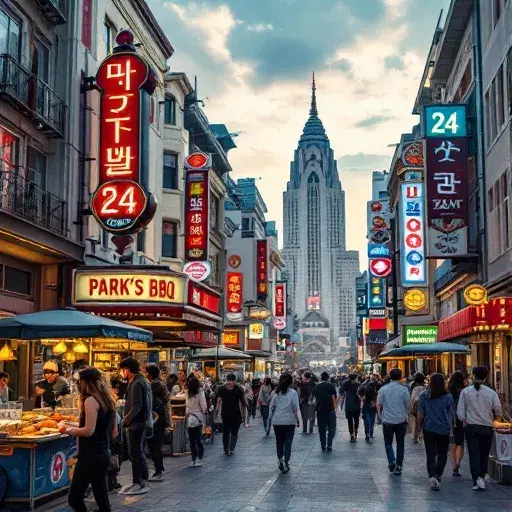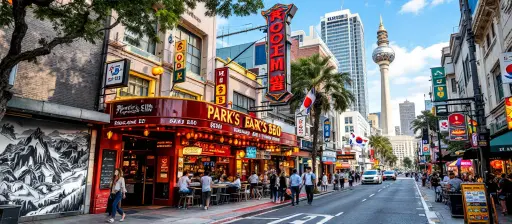Exploring Koreatown: Los Angeles' Vibrant Culinary and Cultural Hub

Nestled in the heart of Los Angeles, Koreatown (often abbreviated as K-Town) is a dynamic, bustling neighborhood that offers one of the most authentic Korean experiences outside of Korea itself. This vibrant enclave spans roughly 3 square miles west of downtown LA and has evolved into one of the city's most exciting culinary and cultural destinations. With its neon-lit streets, 24-hour restaurants, innovative chefs, and rich cultural heritage, Koreatown invites visitors to explore a unique slice of Los Angeles that seamlessly blends Korean traditions with American urban life.

Neighborhood Character & History
Koreatown's landscape is characterized by an eclectic mix of architectural styles, from Art Deco buildings and mid-century structures to modern high-rises and strip malls that house countless treasures within. Colorful murals, Korean signage, and the constant bustle of activity create an energetic atmosphere that feels distinctly different from other Los Angeles neighborhoods. The streets pulse with energy at all hours, with Western Avenue, Olympic Boulevard, and Wilshire Boulevard serving as the main arteries of this vibrant community.
The neighborhood's history dates back to the 1960s when Korean immigrants began establishing businesses in this central Los Angeles area. Following the Immigration Act of 1965, which eased restrictions on Asian immigration, the Korean population in Los Angeles grew substantially. The community expanded dramatically in the 1970s and 1980s as more Korean immigrants arrived and established businesses. The 1992 Los Angeles riots marked a pivotal moment for the neighborhood, as many Korean-owned businesses were damaged. However, the community demonstrated remarkable resilience, rebuilding and eventually transforming Koreatown into the thriving cultural hub it is today, home to the largest Korean population outside of Korea.
Food & Dining Scene
Koreatown's culinary landscape is arguably its biggest draw, offering an unparalleled concentration of Korean restaurants that range from traditional establishments to innovative fusion concepts. The neighborhood is famous for its Korean barbecue restaurants, where tabletop grills sizzle with marinated meats and the air is filled with mouthwatering aromas.
Park's BBQ stands as one of K-Town's premier Korean barbecue destinations, known for its high-quality meats, particularly the USDA Prime beef and perfectly marinated short ribs. The restaurant offers a mid-to-high-end dining experience with attentive service and consistently excellent quality. Their banchan (side dishes) selection is extensive and regularly refreshed throughout your meal.
For late-night cravings, Sun Nong Dan operates 24 hours and specializes in galbi jjim (braised short ribs) that arrive at your table still bubbling in a stone pot. Their signature dish is topped with melted cheese and torched tableside, creating an Instagram-worthy moment. This mid-range restaurant often has lines out the door, especially after midnight.
Soban offers a more refined dining experience focusing on traditional Korean home cooking. Their ganjang gejang (soy sauce-marinated raw crab) is legendary among food enthusiasts, and the restaurant's peaceful atmosphere provides a welcome contrast to some of the neighborhood's more boisterous establishments. This mid-range restaurant requires reservations for dinner.
For those seeking Korean-fusion cuisine, Here's Looking At You blends Korean flavors with global influences in a stylish setting. Their innovative cocktail program complements dishes like kimchi fried rice with foie gras or Korean-inspired tartare. This higher-end establishment showcases how Korean culinary traditions continue to evolve in Los Angeles.
No exploration of Koreatown would be complete without visiting a food court like the one at H Mart or California Market, where you can sample various Korean street foods and specialties at budget-friendly prices. From tteokbokki (spicy rice cakes) to hotteok (sweet filled pancakes), these markets offer an accessible entry point to Korean cuisine.
The neighborhood also hosts the annual KTOWN Night Market, a weekend-long food festival that brings together traditional Korean foods, fusion creations, and pan-Asian delicacies, accompanied by live performances and cultural exhibitions.
Coffee Shops & Bakeries
Koreatown's café culture offers a delightful contrast to its barbecue-dominated food scene, with spaces that range from serene to stylishly modern. Document Coffee Bar combines minimalist design with serious coffee credentials, serving meticulously prepared pour-overs and espresso drinks alongside light Korean-inspired snacks. The café doubles as a creative space, often featuring exhibitions by local artists.
For those with a sweet tooth, Cake House Bakery offers an array of Korean and European-inspired pastries. Their sweet red bean buns, cream-filled cakes, and egg tarts provide a perfect afternoon pick-me-up. The bakery's modest prices make it easy to sample multiple treats.
Alchemist Coffee Project serves specialty coffee in an industrial-chic setting, with baristas who take pride in their craft. Their signature drinks include creative concoctions like honey lavender lattes and matcha espresso fusions. The café also offers a selection of pastries that blend Korean and Western baking traditions.
Shopping & Local Businesses
Shopping in Koreatown offers everything from high-end cosmetics to quirky souvenirs and specialty food items. The Line Hotel Gift Shop curates a selection of design-forward items, Korean beauty products, and unique gifts that reflect the neighborhood's creative energy.
Beauty enthusiasts should visit Palace Beauty in Koreatown Galleria, where you'll find an extensive selection of Korean skincare and cosmetics brands that have gained international cult followings. Staff members are knowledgeable and can help navigate the sometimes overwhelming array of products.
For food shopping, HK Market offers aisles of Korean ingredients, from kimchi and banchan to specialty sauces and snacks. The market's produce section features Asian vegetables that can be hard to find elsewhere in the city, making it a favorite among home cooks seeking authentic ingredients.
Daiso in Koreatown Plaza is a Japanese dollar store that has become a neighborhood institution, offering affordable housewares, stationery, beauty products, and quirky gifts. It's nearly impossible to leave without finding something you didn't know you needed.
Cultural Attractions & Green Spaces
Koreatown's cultural landscape extends beyond its restaurants and shops, offering visitors opportunities to engage with both traditional and contemporary Korean culture. The Korean American National Museum, currently under development, will showcase the history and contributions of Korean Americans when completed.
Architecture enthusiasts should visit Chapman Plaza, a 1920s Spanish Revival marketplace that now houses Korean restaurants and businesses. Its ornate façade and courtyard provide a glimpse into Los Angeles' architectural past while its current tenants represent the neighborhood's present.
The historic Wiltern Theatre, an Art Deco landmark on the edge of Koreatown, hosts concerts and events in a spectacularly preserved 1930s setting. The theater's blue-green terra cotta exterior and lavish interior make it worth visiting even if you're not attending a performance.
For outdoor space in this densely urban neighborhood, Seoul International Park offers sports facilities, walking paths, and community events. On weekend mornings, you might catch groups practicing tai chi or families enjoying picnics under the shade trees.
Nightlife & Entertainment
Koreatown truly comes alive after dark, with some of Los Angeles' most unique nightlife options. The neighborhood is famous for its karaoke rooms, where private spaces allow groups to sing the night away accompanied by food and drinks. Break Room 86 at The Line Hotel offers a nostalgic 1980s-themed karaoke experience with vintage arcade games and creative cocktails.
For a traditional Korean spa experience, Wi Spa operates 24 hours a day, offering hot and cold pools, saunas, and treatment rooms across gender-separated floors and a co-ed relaxation area. It's a cultural institution that provides both relaxation and a glimpse into Korean wellness traditions.
The Prince combines dining and drinking in a vintage setting that has appeared in numerous films and TV shows. The red leather booths, dim lighting, and classic cocktails create an atmosphere that feels simultaneously retro and timeless. Their Korean fried chicken pairs perfectly with a cold beer or soju cocktail.
Conclusion
Koreatown stands as a testament to Los Angeles' multicultural identity, offering visitors an immersive experience that goes far beyond typical tourist attractions. Whether you're feasting on sizzling Korean barbecue at 2 AM, relaxing in a traditional spa, or exploring the neighborhood's architectural gems, K-Town provides a sensory adventure that captures the dynamic spirit of contemporary Korean-American culture. For first-time visitors, consider joining a food tour to navigate the sometimes overwhelming array of dining options, and don't be afraid to venture into places where English isn't the primary language – some of the neighborhood's best experiences await those willing to step outside their comfort zone. As Los Angeles continues to evolve, Koreatown remains one of its most vibrant and authentic neighborhoods, inviting exploration at any hour of the day or night.